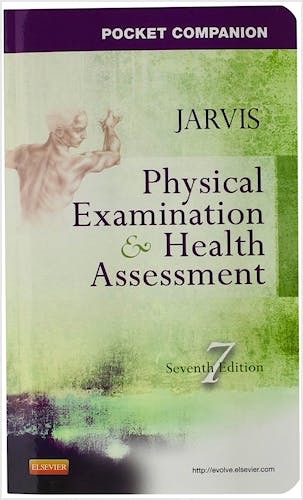

No hay productos en el carrito



Physical Examination and Health Assessment. Pocket Companion
Jarvis, C.
7ª Edición Marzo 2015
Inglés
Tapa blanda
304 pags
300 gr
12 x 21 x 2 cm
ISBN 9780323265379
Editorial Saunders (W.B.) Co Ltd
Description
Take this nursing handbook into the clinical setting! Pocket Companion for Physical Examination & Health Assessment, 7th Edition makes it fast and easy to look up essential assessment skills and techniques. You’ll conduct more effective exams by referring to summaries of examination steps, normal versus abnormal findings, lifespan and multicultural considerations, and over 250 full-color photos and illustrations. Written by well-known educator and clinician Carolyn Jarvis, this handbook is a perfect clinical tool whether you’re a beginner who is learning assessment skills or a practitioner who needs a portable reference!
New to this Edition
- NEW evidence-based guidelines reflect a focus on conducting the most effective, qualitative exams.
- NEW content on the Electronic Health Record, charting, and narrative recording includes examples of how to document assessment findings.
- NEW photos of normal and abnormal findings show the nose, mouth, throat, thorax, and pediatric assessment, including developmental and cultural variations.
Key Features
- Convenient two-column format makes it easier to access, learn, and understand key physical examination skills and findings.
- More than 250 full-color illustrations demonstrate examination skills, underlying anatomy and physiology, and normal and abnormal findings.
- Color-coded design helps you easily locate the information you need, dividing each body system chapter into major sections (anatomy, subjective data, objective data, and abnormal findings).
- Abnormal findings tables help you recognize, sort, and describe key abnormal findings.
- Summary checklists offer reviews of key examination steps for quick reference.
- Developmental Competence sections highlight content specific to infants, children, adolescents, pregnant women, and older adults.
- Spanish-language translation chart helps you improve communication with Hispanic patients during the physical examination.
- Cultural Competence sections provide a context for care of multicultural patient groups.
Table of Contents
1. The Interview and the Health History
2. Mental Status
3. Assessment Techniques and the Clinical Setting
4. The General Survey, Measurement, Vital Signs, and Pain Assessment
5. Skin, Hair, and Nails
6. Head, Face, and Neck, Including Regional Lymphatics
7. Eyes
8. Ears
9. Nose, Mouth, and Throat
10. Breasts and Axillae, Including Regional Lymphatics
11. Thorax and Lungs
12. Heart and Neck Vessels
13. Peripheral Vascular System and Lymphatics
14. Abdomen
15. Musculoskeletal System
16. Neurologic System
17. Male Genitourinary System
18. Female Genitourinary System
19. Anus, Rectum, and Prostate
20. Integration of the Complete Physical Examination
21. Bedside Assessment of the Hospitalized Patient
Author Information
By Carolyn Jarvis, PhD, APN, CNP, Professor, School of Nursing, Illinois Wesleyan University; Nurse Practitioner, Community Health Care Clinic, Bloomington, Illinois
© 2025 Axón Librería S.L.
2.149.0